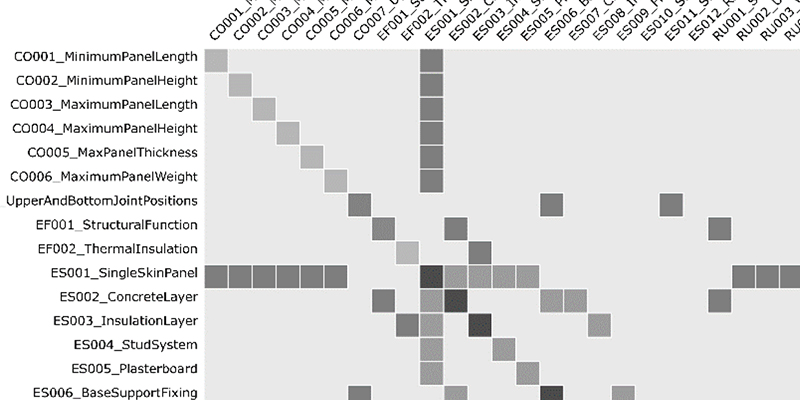Downloads
DOI:
https://doi.org/10.7480/jfde.2017.2.1744Keywords:
façade design, design automation, product configuration, knowledge-based engineering, manufacturability.Abstract
Building façades are Engineer-To-Order (ETO) products and, as such, they show unique features on a project-by-project basis. The partitioning of design tasks during the design and manufacturing process of these products, however, does not fully capture how specific design decisions influence other stakeholders’ choices. This lack of design integration is most severe at early stages when a large proportion of initial costs, mostly driven by manufacturability aspects, is determined. This paper illustrates a methodology to build Knowledge-Based Engineering (KBE) applications to support early-stage design integration through the development of a façade Product Model for automatic rule checking and knowledge reuse. The main outcome is a preliminary framework for developing knowledge-based, digital tools to support and integrate façade design as well as different scenarios in which the tool can potentially be used, based on two types of procurement methods. A prototype of the tool is also shown here. The paper proposes a new paradigm where façade systems are considered to be more closely related to Make-To-Order types, rather than ETOs, in which the product is ready for fabrication and designers can rapidly explore the subcontractor’s manufacturing capabilities and the implications of their design choices. Future work will include tool validation by applying the tool into a specific façade manufacturer’s workflow.
How to Cite
Published
Issue
Section
License
Copyright (c) 2017 Jacopo Montali, Mauro Overend, P. Michael Pelken, Sauchelli Michele

This work is licensed under a Creative Commons Attribution 4.0 International License.
Authors or their institutions retain copyright to their publications without restrictions.
References
Aram, S., Eastman, C., & Sacks, R. (2014). A Knowledge-Based Framework for Quantity Takeoff and Cost Estimation in the AEC Industry Using BIM. In The 31st International Symposium on Automation and Robotics in Construction and Mining (p. 1). Vilnius: Vilnius Gediminas Technical University, Department of Construction Economics & Property.
Author’s webpage. (2016). Retrieved from http://www2.eng.cam.ac.uk/~jm2026/jm_web/ResearchWork/kbe-tool-use-cases/index.html
BPMN. (2017). Retrieved from http://www.bpmn.org/
Cooper, S., Fan, I., & Li, G. (2001). Achieving Competitive Advantage through Knowledge-Based Engineering. University of Cranford.
Curran, R., Verhagen, W. J. C., & Van Tooren, M. J. L. (2010). The KNOMAD methodology for integration of multi-disciplinary engineering knowledge within aerospace production. 48th AIAA Aerospace Sciences Meeting Including the New Horizons Forum and Aerospace Exposition, (January), 1–16. http://doi.org/10.2514/6.2010-1315
Emberey, C. L., & Milton, N. R. (2007). Application of Knowledge Engineering Methodologies to Support Engineering Design Application Development in Aerospace. 7th AIAA Aviation Technology, Integration and Operations Conference (ATIO), (September), 18–20.
Fuchs, A., Peters, S., Hans, O., & Möhring, J. (2015). Schüco Parametric System - Uniqueness in Series. In Advanced Building Skins. Graatz.
Hansen, B. L. (2003). Development of Industrial Variant Specification Systems. B.L. Hansen, Development of industrial variant specification systems, Ph.D. Thesis. Technical University of Denmark, Lyngby, 2003.
Karhu, V. (1997). Product Model Based Design of Precast Façades. ITcon Journal, 2(November 1996).
Knowledge Transfer Network. (2016). High Value Manufacturing - Modelling and Simulation Best Practice (SimBest) - WP4 State of the Art Deliverable.
La Rocca, G. (2012). Knowledge Based Engineering: Between AI and CAD. Review of a Language Based Technology to Support Engineering Design. Advanced Engineering Informatics, 26(2), 159–179. http://doi.org/10.1016/j.aei.2012.02.002
Lindemann, U., Maurer, M., & Braun, T. (2009). Structural Complexity Management - An Approach for the Field of Product Design. Berlin: Springer. http://doi.org/10.1007/978-3-540-87889-6
Milton, N. R. (2007). Knowledge Acquisition in Practice: A Step-by-step Guide (1st ed.). Springer-Verlag London. http://doi.org/10.1007/978-1-84628-861-6
Montali, J., Overend, M., Pelken, P. M., & Sauchelli, M. (2017). Knowledge-Based Engineering Applications for Suporting the Design of Precast Concrete Façade Panels. In ICED17: International Conference of Engineering Design (in print). Vancouver.
OMG. (2016). UML. Retrieved from http://www.uml.org/
Reddy, E. J., Sridhar, C. N. V, & Rangadu, V. P. (2015). Knowledge Based Engineering : Notion , Approaches and Future Trends, 5(1), 1–17. http://doi.org/10.5923/j.ajis.20150501.01
RIBA. (2013). RIBA Plan of Work 2013 Overview.
Rudberg, M., & Wikner, J. (2004). Mass customization in terms of the customer order decoupling point. Production Planning & Control, 15(4), 445–458. http://doi.org/10.1080/0953728042000238764
Stokes, M. (2001). Managing Engineering Knowledge – MOKA: Methodology for Knowledge Based Engineering Applications. (Professional Engineering Publ., Ed.). ASME Press.
Voss, E., & Overend, M. (2012). A Tool that Combines Building Information Modeling and Knowledge Based Engineering to Assess Façade Manufacturability. In Advanced Building Skins. Gratz.
Zahner. (2016). ShopFloor. Retrieved from http://www.shopfloorapp.com/
